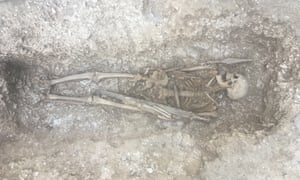Soldiers find skeleton of Saxon warrior on Salisbury Plain
https://www.theguardian.com/science/2018/jul/25/soldiers-find-skeleton-of-saxon-warrior-on-salisbury-plain Afghanistan war veterans helping out with archaeological dig on military grounds found scores of Saxon burials complete with weapons and jewellery

Maev Kennedy
Wed 25 Jul 2018 10.46 EDT Last modified on Wed 25 Jul 2018 15.30 EDT
The skeleton of a 6th century warrior in his grave.
This 6th century Saxon warrior with spear and sword, was found underneath a military trackway, frequently crossed by tanks and huge military vehicles. Photograph: Handout
On the last day of an excavation by soldiers within the military training lands on Salisbury Plain, they found a comrade in arms: the grave of a 6th century Saxon warrior, buried with his spear by his side and his sword in his arms.
His bones and possessions, which included a handsome belt buckle, a knife and tweezers, were remarkably well preserved despite his grave lying under a military trackway on which tanks and massive military vehicles have been trundling across the plain. Pattern welded swords, high status objects, are rarely found intact: his was lifted in one piece, complete with traces of its wood and leather scabbard.
The soldiers were very moved by the discovery of a man they felt would have shared some of their experiences. They joined the excavation at Barrow Clump as part of Operation Nightingale, an initiative to help the recovery of veterans of recent conflicts, particularly Afghanistan, by involving them in archaeology. The scheme, working with Wessex Archaeology, has been so successful that several of the veterans have retrained as professional archaeologists.
“It was a classic last day of the dig find – there was such a buzz across the site, the soldiers definitely had a sense of kinship,” Richard Osgood, senior archaeologist with the Defence Infrastructure Organisation said. “I have to admit I also thought ‘there goes my budget’ – there was quite a tricky conversation afterwards with the MoD because of the sudden increase in conservation costs.”
The finds have been taken for further study and conservation work at Wessex Archaeology, and will eventually be given to the Wiltshire Museum in Devizes.
Barrow Clump has a remarkably long history of human activity. The Bronze Age burial mound built on an even older Neolithic settlement, was reused as an Anglo-Saxon cemetery. It had already been damaged by ploughing, but permission to excavate a listed site was granted because of damage by more recent trouble makers – badgers which were burrowing out the entire site, and kicking out human bones as they dug.
This year’s excavation was just beside the burial mound – “the badgers are happily back in residence in the barrow now” Osgood said – carried out in scorching heat and clay as hard as concrete, to investigate the extent of the cemetery, and the condition of any archaeology under the trackway.
The three week excavation uncovered scores of Saxon burials, men around the edge of the site, women and children in the centre, with grave goods including weapons and jewellery. They included a man with a less well preserved sword, and a little girl buried with a large amber bead. One of the graves held a young boy buried curled as if in sleep, one of the few without any grave goods.
The splendidly armed warrior was found when a metal detector being used for a last sweep of the site on the final afternoon gave an unusually strong signal.
The archaeology, Osgood said, was generally better preserved than in the ploughed fields outside the army lands. “We found one grave directly below the track, and the skull, only five centimetres down, hadn’t even been cracked – so from a curatorial point of view that was very reassuring.
He believes the dead came from a settlement in the valley below: “It’s that Saxon thing of looking up the hill and knowing your ancestors are up there on a site that was already ancient and special.”
Topics